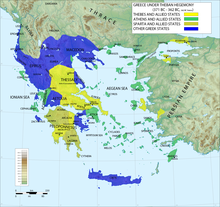Theban hegemony
Appearance
This article needs additional citations for verification. (October 2014) |

The Macedon in 346 BC.
Externally, the way was paved for Theban ascendancy by the collapse of Athenian power in the Peloponnesian War (431–404 BC), through the weakening of the Spartans by their oliganthropia (demographic decline) and by the inconclusive Corinthian War (395–386 BC). Internally, the Thebans enjoyed two temporary military advantages:
- The leaders of the Theban oligarchy at the time, Epaminondas and Pelopidas, were fully committed to an aggressive foreign policy and could be relied on to win any battle and
- The same leaders had instituted tactical improvements in the Theban heavy infantry (e.g. longer spears, the use of a wedge-shaped formation of spearmen), which had yet to catch on among their rivals.

The Thebans had traditionally enjoyed the hegemony of the
Arcadians from Spartan overlordship and set up a pro-Theban Arcadian League to oversee Peloponnesian affairs. In the north, they invaded Thessaly, to crush the growing local power of Pherae and took the future Philip II of Macedon hostage, bringing him to Thebes. Pelopidas, however was killed at Cynoscephalae
, in battle against troops from Pherae (though the battle was actually won by the Thebans).
The Thebans overstretched themselves strategically and, in their efforts to maintain control of the north, their power in the south disintegrated. The Spartan king,
rise of Macedon
within Greece and finally brought to an end a Theban hegemony which had already been in decline.
See also
References
- John Buckler, The Theban Hegemony 371-362, 1980.
